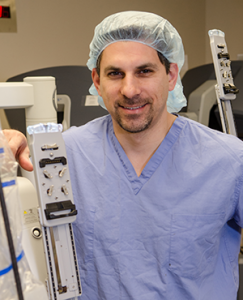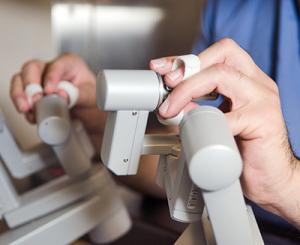Minimally Invasive Surgeon Keith Mortman, M.D., Joins GW
Throughout his adolescence, Keith Mortman, M.D., dreamed of becoming a major league first baseman. “Thoracic surgery was the fallback plan when the New York Mets decided not to recruit me,” he jokes. Instead of a glove and a bat, the tools of Mortman’s trade today are the robotic arms that he uses to perform minimally invasive thoracic surgery using miniaturized instruments and a high-definition 3-D camera.

“Minimally invasive chest surgery isn’t just about having smaller incisions that are cosmetically acceptable,” explains Mortman, who joined GW’s School of Medicine and Health Sciences (SMHS) as an associate professor of surgery in October 2013. “There is less pain, shorter drainage tube durations, and, in turn, shorter hospital stays.” Mortman, who serves as director of thoracic surgery at the GW Medical Faculty Associates (MFA), performs nearly 90 percent of his cases using minimally invasive procedures. “Almost every patient who walks into my clinic starts out as a minimally invasive candidate,” Mortman says. A number of advantages to the approach have been recognized since the mid-1990s, and recent studies show that there could be survival benefits as well. “A lung cancer patient who has a minimally invasive lobectomy is able to tolerate more of the prescribed chemotherapy after surgery than a patient who undergoes an open lobectomy,” Mortman says. “It’s the holy grail — the patient is going to live longer.”
Prior to joining the SMHS faculty, Mortman served as director of thoracic surgery at MedStar Washington Hospital Center, where he launched the robotic thoracic program in 2011. “The robot has very clear advantages for particular cases,” he says. “It improves visualization, increases instrument precision, and minimizes surgeon fatigue.” Mortman also appreciates the teaching opportunities afforded by the dual console available at the GW Hospital. “By sitting at the second console, the general surgery residents can have the same visualization as I do, and I can give them control of anywhere from one to all four of the robotic arms.”
Mortman says he was attracted to GW for its reputation as a teaching institution. “I have a couple of gray hairs now,” he notes, “but not so many that I’ve forgotten what it’s like to be a resident or medical student. I was fortunate to have great mentors and educators during my training, so I think it’s important to return that favor and educate the next generation.” Mortman’s efforts on this front have not gone unrecognized — he was honored with the Edward Cornwell Award for Teaching Excellence and the Keystone Award for Excellence in Resident Education in 2013.

Anton Sidawy, M.D., M.P.H., Lewis B. Saltz Professor and chair of surgery at SMHS, says that Mortman embodies the full package necessary to advance the thoracic surgery program at GW. “He has the experience, the know-how, and the skills — whether open surgical skills, video-controlled thoracoscopy skills, or robotic surgical skills — to be a well-rounded addition to the team,” Sidawy says.
“By sitting at the second console, the general surgery residents can have the same visualization as I do, and I can give them control of anywhere from one to all four of the robotic arms.” —Keith Mortman, M.D.
Under Sidawy’s leadership, Mortman is striving to make GW the “go-to regional thoracic surgery program.” He plans to build upon the successes of Sidawy and Gregory Trachiotis, M.D., professor of surgery at SMHS and chief of cardiothoracic surgery at the MFA, to draw patients from across the D.C. metropolitan area for specialized care. “When somebody thinks thoracic surgery, I want them to think GW’s the place to be. That’s the challenge I accepted,” Mortman says.
With such ambitious aspirations for GW’s thoracic surgery program, Mortman will have to put his athletic dreams on hold a bit longer. In the meantime, there’s always the Department of Surgery softball team. “That’s what really brought me to GW,” Mortman says with a grin.



